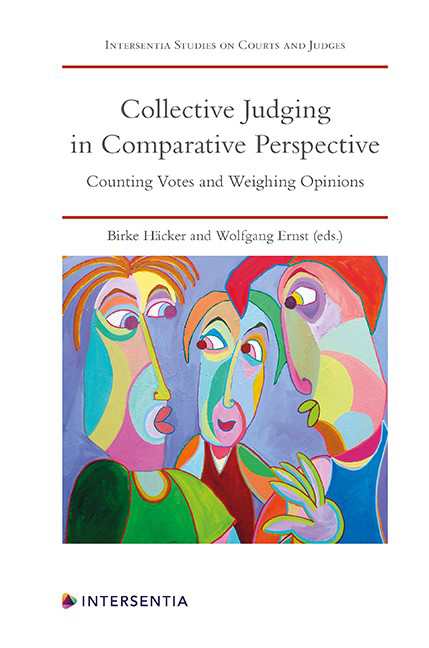Book contents
- Frontmatter
- Preface
- Contents
- List of Cases
- List of Contributors
- PART I DESIGNING COLLEGIATE COURTS’DECISION-MAKING PROCESSES
- PART II COLLEGIATE COURTS IN THE COMMON LAW TRADITION
- PART III COLLEGIATE COURTS IN THE EUROPEAN CIVIL LAW TRADITION
- PART IV COLLEGIATE COURTS IN A NON-EUROPEAN CIVIL LAW JURISDICTION: THE CASE OF JAPAN
- PART V SUPRANATIONAL AND INTERNATIONAL COLLEGIATE COURTS
- PART VI VOICES FROM THE AUDIENCE AND CLOSING REMARKS
- About the Editors
Chapter 6 - Collective Judging in the French Cour de Cassation
Published online by Cambridge University Press: 09 February 2021
- Frontmatter
- Preface
- Contents
- List of Cases
- List of Contributors
- PART I DESIGNING COLLEGIATE COURTS’DECISION-MAKING PROCESSES
- PART II COLLEGIATE COURTS IN THE COMMON LAW TRADITION
- PART III COLLEGIATE COURTS IN THE EUROPEAN CIVIL LAW TRADITION
- PART IV COLLEGIATE COURTS IN A NON-EUROPEAN CIVIL LAW JURISDICTION: THE CASE OF JAPAN
- PART V SUPRANATIONAL AND INTERNATIONAL COLLEGIATE COURTS
- PART VI VOICES FROM THE AUDIENCE AND CLOSING REMARKS
- About the Editors
Summary
INTRODUCTION
The expression of collegiality in the decision-making process is as diverse as there are types of jurisdictional organisations. At any rate, collegiality cannot be reduced to decision by bare majority.
Because of a particular distrust of the judiciary in France, originating in the Revolutionary period, the judicial function has historically been split among countless small-sized courts which assume their role collegially in a manner that leaves no room in the making of the judgment to the personal individuality of judges. The judiciary is regarded as a branch of the civil service, where collegiality is traditionally perceived as a safeguard against the passions and arbitrariness of those who should not have been awarded a judicial position in the first place as well as a tool to counterbalance the lower level of experience of the most junior judicial panel members.
The function of a supreme court has repercussions on its internal organisation and on the rules of procedure which, in turn, influence the collegial decisionmaking process.
The Cour de cassation, which is the apex court of the general court system, was created in 1790 as a body attached to the National Assembly without power to interpret statute law. It was not before 1837 that the Cour de cassation, sitting in plenary session, could impose its decisions on the lower courts without referring questions of interpretation to the legislative branch of government.
In the context of an absence of an independent constitutional power, the Cour de cassation‘s role, although not that of an agent of the legislature today, is confined to applying statutes to the disputed cases, if need be, in interpreting statutory law, but – in doing so – only legal arguments can be made.
The so-called ‘motivation‘ of the judgment is necessarily brief, as is the statutory provision to be interpreted and applied. The Cour de cassation cannot modify, add or subtract anything to written law, nor even does the Court have to explain the interpretative method it uses.
- Type
- Chapter
- Information
- Collective Judging in Comparative PerspectiveCounting Votes and Weighing Opinions, pp. 129 - 140Publisher: IntersentiaPrint publication year: 2020

